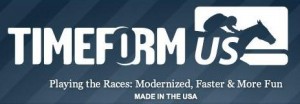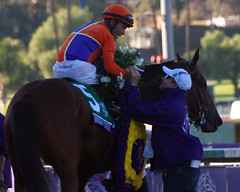How Did They Do It? A Visual Handicapping Lesson
Continuing on the theme of a prior article on “Visual Handicapping” we’re going to get into more details on questions raised there. Click here to review the visual handicapping article, and learn more about the differences between visual handicapping and trip handicapping.
With visual handicapping, it’s always important to look beyond the raw numbers (i.e. Beyer Speed Figures, Pace Figures, Running Lines) in the Daily Racing Form and ask the question, “How did they do it?”
We raised some of these questions before, but we’ll ask them again:
- How much running did the horse do on their own?
- Was the jockey asking for an all out effort from the horse?
- Was the jockey riding the the horse confidently?
Video replays are your best source of information to answer these questions. Not only can you watch the horse and the jockey for yourself, but you can listen closely to the descriptions used by the track announcer. In a prior article about track announcer John Lies, he described his approach to announcing details, such as the jockey’s body language, the position of his hands, use of his whip, the position of the horse’s head and ears, how comfortably he’s running, and whether or not he’s fully extended. All of this information can be used to answer the question, “How did they do it?”
As an example, let’s review two main contenders (Beholder and Royal Delta) in the 2013 Breeders’ Cup Distaff race, and watch each of their races that immediately preceded the Breeders’ Cup race. First let’s watch Beholder in the Zenyatta Stakes on September 28, 2013.
Here are some of the comments Trevor Denman made about Beholder during the race:
- “Has not been asked to run yet.”
- “Gary Stevens is super confident, he hasn’t moved on her yet.”
- “Gary Stevens barely moved on her. Couldn’t have been more impressive.”
Contrast these comments with the official trip note from the Daily Racing Form for Beholder in this race, “Inside, ridden out.” The latter doesn’t give the handicapper much insight into the question of “How did she do it?” In addition to this, the running line for her race showed her ahead by 3-lengths during the stretch, but winning by only 11/4 lengths at the finish. A handicapper just looking at the numbers might wonder if Beholder was running out of gas at the end of the race. But, after watching the video replay, and listening to Trevor’s comments, you know that was not the case.
Now, let’s contrast that prep race to the race Royal Delta ran leading up to the Breeder’s Cup, the Beldame Stakes on September 28, 2013.
The DRF comment reads “Pressed, led, 2nd best.” But, what kind of “2nd best?” After being headed, did she fight back? Was the jockey asking her for run down the stretch? After watching the video replay, my answer to these questions was “not really” and “yes, Mike Smith was urging her along until the final stages when she was clearly beaten.” If you’ve read my prior article on Royal Delta you know I’m a big fan of hers, but this didn’t look like the same horse I’d seen at Saratoga back in August.
So, based upon the visual handicapping evidence, which horse should you prefer in the Breeder’s Cup Distaff? And, factor in that Royal Delta went off as the 7-5 favorite, and Beholder was more than 5-2 at post time. Here is the video race replay:
“With authority,” is how Larry Collmus described Beholder’s Breeders’ Cup victory. And it sure looked similar to “How She Did It” in the Zenyatta Stakes.
Visual Handicapping takes extra time, but when you obtain answers to the “How Did They Do It?” question (especially when that information is not in the printed PPs) … this can be time well spent.
If you don’t want to miss any of our future articles, we recommend that you subscribe to the Blog via e-mail and/or follow us on Facebook or Twitter.

For everyone that subscribes to the Getting Out Of The Gate Blog via the e-mail option, they will automatically be entered into a drawing to win a FREE FULL YEAR of PPs provided by TimeformUS. This a $699 value. Thanks TimeformUS! The winner will be drawn randomly on April 1, 2015. You can subscribe below.
*** Existing e-mail subscribers: You will be included in the drawing for the free year of PPs from TimeformUS.
[jetpack_subscription_form title=”Subscribe To Our Blog Via E-Mail” subscribe_text=”Enter your e-mail address to subscribe and receive notifications of new articles by e-mail. A confirmation message will be sent to you before your subscription becomes active.” subscribe_button=”Sign Me Up” show_subscribers_total=”0″]


3 comments on “How Did They Do It? A Visual Handicapping Lesson”